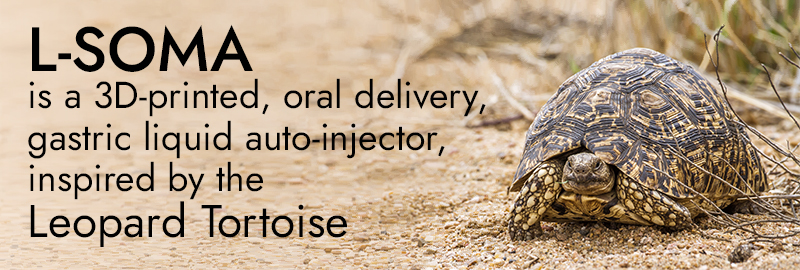L-SOMA Gastric Auto-Injectors
The majority of the world’s population very rarely thinks of the route of administration needed to maximize the efficiency of a drug. You have a headache, swallow a Tylenol, allergies intranasal delivery “snort” Flonase, having an asthma attack inhale Albuterol, or you accidentally bit into a peanut butter cookie thinking it was a snickerdoodle; now your throat is closing shut as you go into anaphylaxis, then subcutaneous injection with an epinephrine pen it is.
These are just a small fraction of how we get drugs into the body. However, one of the major hurdles is getting large macromolecules like proteins, antibodies, and other large biologic drugs into systemic circulation. The preferred route for macromolecule delivery is an injection, whether a subcutaneous injection (as seen with insulin patients) or intravenous administration (clinical application only). These routes are preferred over an oral delivery method due to poor bioavailability and enzymatic degradation in the stomach and GI tract of these molecules.
Very few people enjoy needles or injections of any kind. In some cultures, there is a negative stigma involved with injecting drugs like insulin; thus, proper care that the patient may need will be avoided at all costs. Therefore, there is a clinical need to provide alternate routes of drug administration to patients in order to maximize treatment efficacy, minimize patient harm, increase patient compliance, and reduce medical costs.
Recently there has been a significant leap in how biomacromolecules are delivered. Oral delivery of any medication is simple and non-invasive; however, small molecules can withstand a myriad of harsh biological environments in order to reach their targets, such as the acidity of the stomach or enzymatic degradation in the gastrointestinal tract. Unfortunately, large biomacromolecules are susceptible to the environments small molecules elude; thus, preventing their oral delivery. Scientists have developed an orally dosed liquid auto-injector to circumvent the self-administration of therapeutic substances via a needle.
The liquid auto-injector, named L-SOMA, is 3D printed with a 12mm diameter and a 15mm height and uses a 32g needle for liquid delivery. Orientation is critical in the successful engineering and application of this device. Interestingly, to solve this problem, the researchers have taken inspiration from the animal kingdom, more specifically, the leopard tortoise. This animal has the ability to self-orient from any orientation or configuration. To achieve this ability, they constructed the auto-injector with the upper portion of the device having a high curvature and a low center of gravity to ensure only one stable orientation. Furthermore, the device has a flat bottom to help further stabilize it, ensuring it does not tip over and misfire.
They designed L-SOMA to deliver up to a 4mg dose of a drug that can reach an absolute bioavailability of 80%, a maximum plasma concentration in 30 min as well as having the pharmacokinetics of an intravenous injection. Four model drugs were used to test the efficacy of the liquid auto-injector, each with increasing size, epinephrine < recombinant human insulin < a GLP-1 analog < adalimumab. The drugs at clinically relevant doses were delivered to a swine animal model using a multi-day dosing regimen. L-SOMA showed comparable pharmacokinetics and efficacy to their parenteral delivery within a clinical setting. This new and novel liquid auto-injector allows the delivery of a wide range of biomacromolecules that vary in molecular weight in a non-invasive manner allowing for the versatility of an oral formulation with the efficacy of an intravenous injection.
Visit us at Axxiem.com
